It is not an easy task to classify all the Ethiopian traditional dresses because there are so many. Each of the different ethnic groups and tribes has its varieties in terms of clothing styles.
Ethiopia is a massive country that has a vast range of climates. This is why they do not have one specific type of traditional dress. There is some commonly used ethiopian traditional clothes you can try. But you have to careful; because, people living in one region will want to avoid wearing clothes commonly worn in another part of the country.
In this article, we will look at the different Ethiopian traditional dresses you will come across and how to style them.
Habesha Kemis
Habesha Kemis is an Ethiopian traditional dress that women mostly wear. The dress is ankle-length and made from chiffon. These dresses are worn in the summer and regions where the sun shines brightest, as chiffon-made dresses are very airy and lightweight.
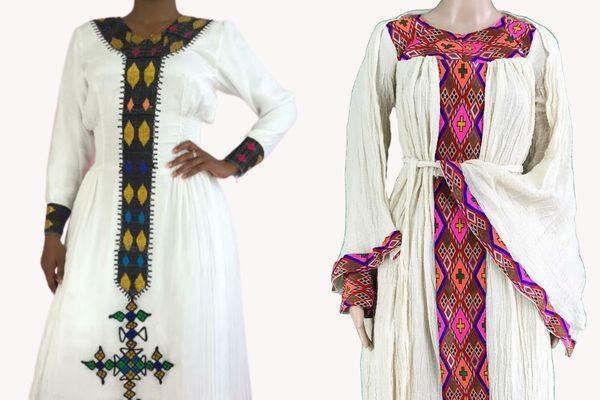
Usually, they come in light colours to keep the wearer cool during the hot weather. The hem of the sleeves and at the bottom is a thick embroidered lace which gives the dress a pop of colour. Not just that, but the dress has various colourful patterns on the edge of it. The Habesha Kemis is worn mostly at formal events.
Netela
Usually, the Netela is worn with the Habesha Kemis. It is a delicate and thin scarf that is made from cotton. The scarf is approximately 160 x 260 cm or 63 x 102 inches. The Netela mostly consists of embroidery at the ends that match the embroidery on the Habesha Kemis. In Ethiopia, the Netela is a way to express the wearer’s emotions. It is used to communicate with the wearer about their actions or feelings.
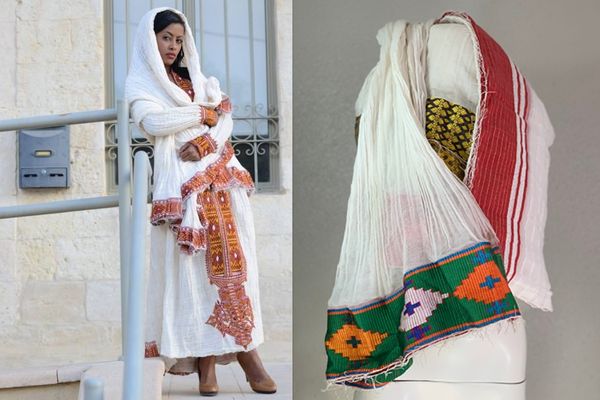
The usual way to wear a Netela is by covering the back and shoulders of the wearer with the embroidery part, which is then folded over the right shoulder. Suppose the wearer is participating in any religious occasion. The Netela is wrapped over the back, and the embroidered part stays folded on the right shoulder. If the wearer is unbothered, the shawl stays over the left shoulder with the embroidery on the front.
Fota
The Fota is another type of shawl considered a type of Ethiopian traditional dresses or attire. It usually consists of checks and is bright, but it looks like a towel. A Fota is about 58 x 105 or 147 x 268 inches. They are very soft to the touch, which makes them more appealing to everyone.
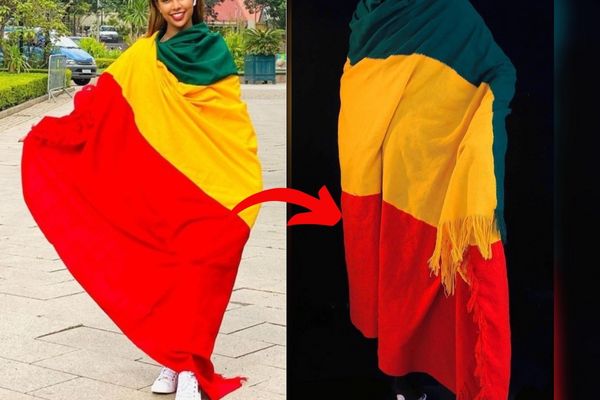
Some of the Fota have simple, intricate designs at the bottom of the shawl, while others are plain. Many Fota has all the colours of the Ethiopian flag, and people can wear them during important patriotic events. Those can cover the entire body because they are huge.
Docho
Docho is another form of the shawl specifically worn by married women. They are very long, about eight meters to twenty-six feet long. This helps to cover up the entire body of married women. You will not find any unmarried women to wear the Docho. Ethiopian Women wear the Docho with the Habesha Kamis like a shawl.
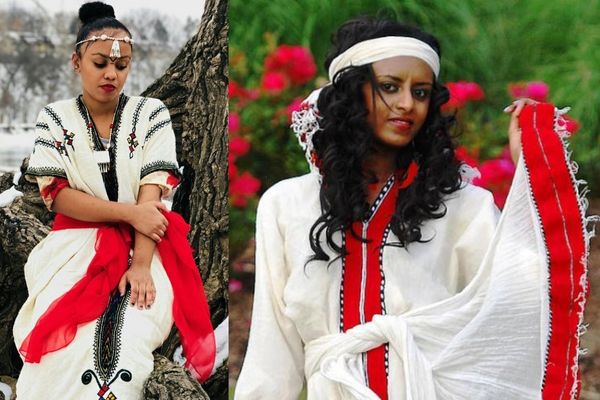
The Docho is always made from chiffon, and they are very lightweight. It is ensured that the wearer does not have to sweat through the Docho since married women have to wear this shawl almost the entire day. The shawl lets air pass through it, which helps in keeping the wearer cool even if the outside temperature rises.
Gabi
Now comes another type of Ethiopian traditional shawl, which is known as the Gabi. These are handmade cloth garment which is usually woven using white cotton. The bottom of the shawl consists of a bold strip featuring various colours or just the colours of the national flag of Ethiopia.
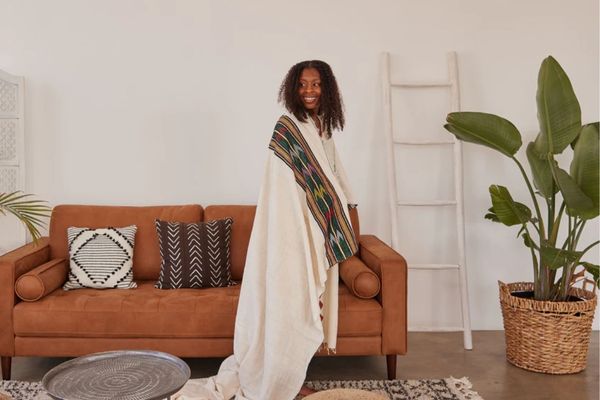
Both men and women can wear this garment, which is worn by draping around the shoulders. In most cases, the Gabi is given to the wearer as a gift. If someone has accomplished something great, the Gabi is gifted to them as a symbol of respect and honouring their hard work.
Tibeb Dress
The Tibeb dress is one of the most beautiful and eye-catching Ethiopian traditional dresses anyone can see. If you are visiting Ethiopia, you can bring back one of the Tibeb dresses as a souvenir. It is a long white white ethiopian traditional dress with colourful embroidery on the front and the bottom of the dress.
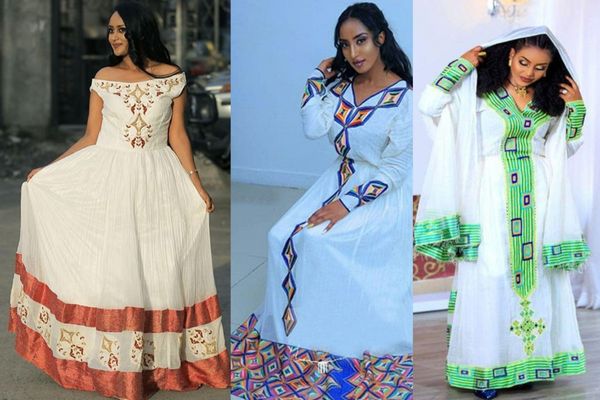
The dress comes with a transformable V-neckline or off-shoulder so that you can get anyone from either. These dresses are usually handmade, and you can find them in local stores at an affordable price. While visiting Ethiopia, you will notice that many foreigners wear this dress as they look beautiful and represents the culture of Ethiopia.
Lalo Bega Dress
The lalo Bega dress is a long white dress that is perfect for the summer. The white colour helps to keep the wearer cool even if the sun is shining bright. The dress usually has embroidery designs on the chest area and at the bottom of the skirt.

Usually, the dress is sleeveless, but you can also find ones with sleeves. The embroidery is hand-woven, which means the dress is handmade. The base colour of the dress is creamy cotton, and the embroidery colours are bright or in combination. You can find the dress in many shops in malls or outside.
Ethiopian Traditional Dress Summary:
The Ethiopian traditional dresses are very beautiful and comfortable to wear. They look amazing on Ethiopian women and anyone who can wear them with style. Apart from that, these dresses are manufactured in such a way which is ensured to keep the wearer cool during the hot weather. Most of the dresses are handmade and can be found in local shops.
Purchasing them is going to help small businesses, which women usually run. If you ever plan to visit Ethiopia, remember to bring back one of their traditional dresses as a souvenir. The Ethiopian traditional dresses are one of their pride and they represent a lot of the culture and history of Ethiopia.
You may read our other traditional dresses article:
- Japanese Traditional Clothing
- Chinese Traditional Dress Male and Female
- Traditional Clothes China for Men and Women
- Korean Traditional Clothing Male and Female
- Traditional Clothing of France
- Russian Traditional Clothing For Male and Female
- Indian Traditional Ethnic Clothing
- African Traditional Dress
- Traditional American Dress Male and Female
- Traditional Mexican Dress for Women
- Traditional Mexican Wedding Dresses You Can Try
- Traditional Mexican Blouses You May Try
